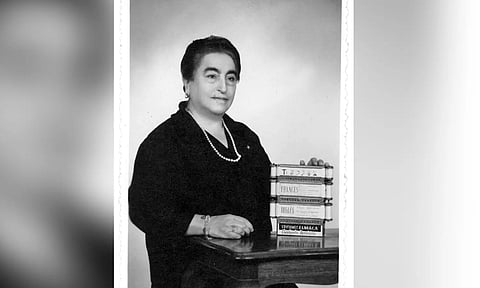

By Cindy Shmerler
NEW YORK: More than 60 years before Kindles, Nooks, iPads and other electronic devices revolutionized reading, there was a gadget invented in a village in Spain that had the potential to do the same. The Enciclopedia Mecanica, or Mechanical Encyclopedia, as it was known, was not the brainchild of a multinational corporation like Apple or Amazon; it was invented in 1948 by Angela Ruiz Robles, a widowed teacher who wanted to make learning easier for her students and her three daughters.
Her invention, a pale green box about the size of a textbook with an intricate interior, allowed a user to read words in any language and on any topic. It was intended to lighten a student’s book load. Today it is seen by many as an analog ancestor of the e-reader.
“What she invented carried on into the future,” her grandson Daniel Gonzalez de la Rivera said by phone from his home in Madrid. He added, “Each time I see one I am reminded of my grandmother.” Within the Mechanical Encyclopedia’s covers were three horizontal spools that held scrolls, each of which could be swapped out for another, on a different topic. The scrolls might hold text, line drawings or ornamental sketches, and the encyclopedia, which was battery operated, contained a lightbulb, so users could read in the dark. Ruiz Robles created the device, and the scrolls along with it, “to get maximum knowledge with minimum effort,” as she told the newspaper Pueblo in 1958.
The machine, which Ruiz Robles called “a mechanical, electrical and air pressure procedure for reading books,” received Spanish patent 190,698 in 1949. A prototype received another patent, 276,346, when it was assembled in 1962 in the Ferrol Shipyard, with Robles overseeing the work.
Decades later, in November 2007, Amazon introduced the Kindle, with a six-inch electronic ink screen that allowed users to download and read some 88,000 books and magazines. The devices sold out in less than six hours. This year, wordsrated.com, a research organization devoted to the publishing industry, reported that 15.92 million e-books were being produced every month.
In her day, however, Ruiz Robles could not muster much manufacturing support. Despite repeated efforts, she failed to persuade financiers to fund her creation, and it was never widely produced.
Today, the prototype of Ruiz Robles’s Mechanical Encyclopedia is displayed at the National Museum of Science and Technology in A Coruna, Spain, a source of pride for her country and a testament to what might have been. In her Pueblo interview, she asked: “Can a good inventor be a good housewife at the same time? Yes, yes, but it is necessary that the servants or people around her do not force her into extensive conversations of ordinary things. Silence is essential as it facilitates the gestation of those ideas which then favor the progress of the world.”
In 1947, Ruiz Robles was awarded the Cross of Alfonso X the Wise for her innovations in the field of education, research and social work. In 1952, she was awarded a gold medal at an exhibition for Spanish inventors.